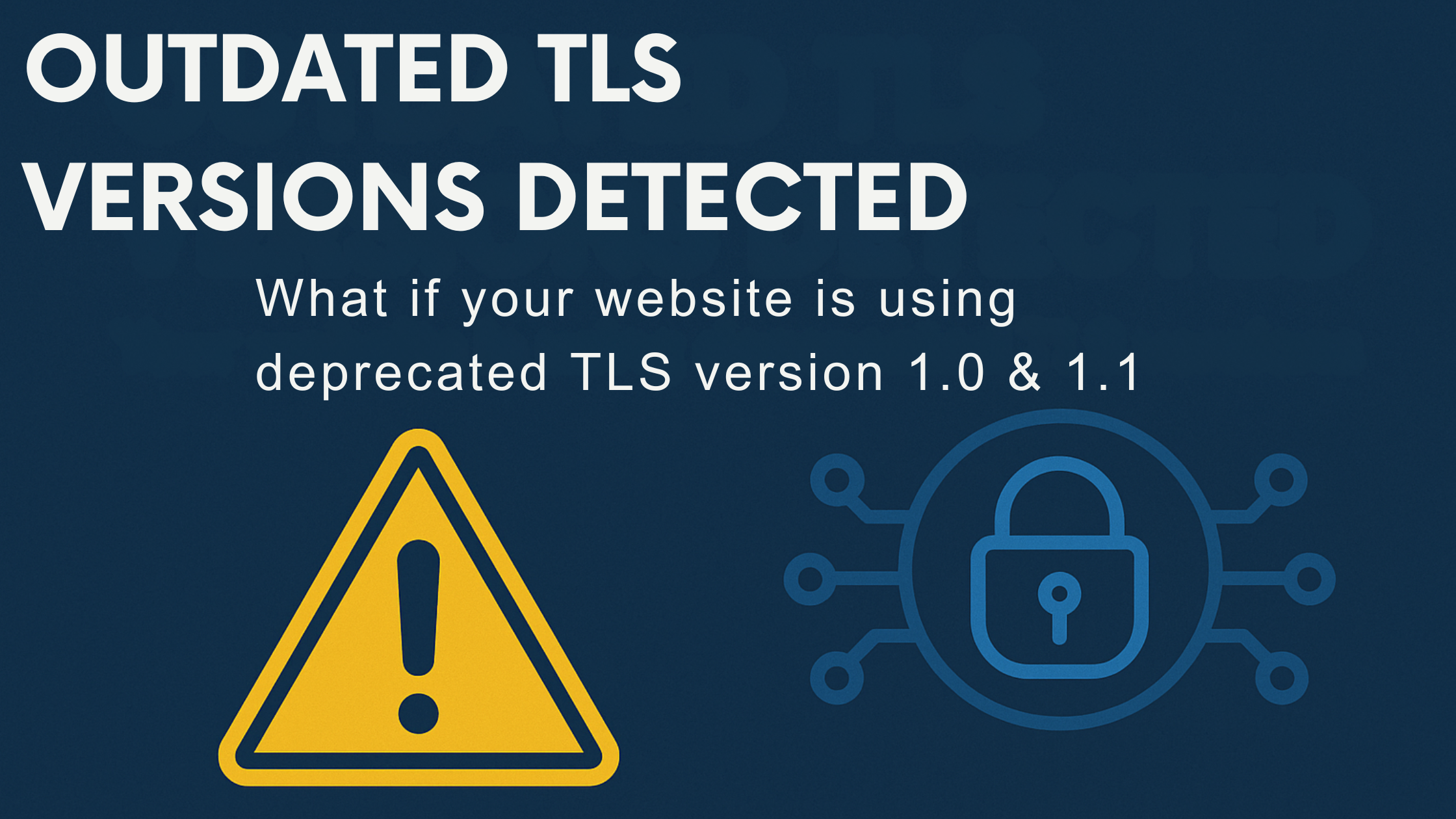Outdated TLS Versions Detected: Why TLS 1.0 and 1.1 Must Be Disabled
In today’s threat landscape, strong encryption is no longer a luxury—it’s a necessity. Yet, many organizations continue to expose themselves to unnecessary risk by allowing older and insecure versions of TLS (Transport Layer Security) to remain enabled on their servers.
What Is the TLS 1.0 / 1.1 Vulnerability?
TLS (Transport Layer Security) is the cryptographic protocol that secures communication over the internet—used by websites, email servers, APIs, and more. TLS 1.0 was introduced in 1999 and TLS 1.1 in 2006. At the time, they offered a reasonable level of security.
However, both versions have serious flaws by modern standards:
- They rely on outdated cryptographic algorithms like SHA-1.
- They lack support for strong cipher suites.
- They are vulnerable to downgrade attacks, where a connection is forced to fall back to a weaker protocol.
These weaknesses led all major browser vendors and standards organizations—including the Internet Engineering Task Force (IETF)—to formally deprecate TLS 1.0 and 1.1. Despite this, many servers still have them enabled by default, often for compatibility with legacy systems.
How Can Attackers Exploit This?
While TLS 1.0 and 1.1 may not be directly exploitable in all cases, their presence makes systems inherently less secure. Here’s how attackers may take advantage:
- Downgrade attacks: Attackers can force a client-server connection to use TLS 1.0 even if both support stronger versions, allowing easier exploitation.
- Exploiting weak cipher suites: These versions permit ciphers that are now considered cryptographically broken or insecure.
- Information leakage: Flaws like BEAST (Browser Exploit Against SSL/TLS) and others can be used to capture or manipulate encrypted traffic under specific conditions.
- Non-compliance: Exposure of older TLS protocols may lead to regulatory non-compliance (e.g., PCI DSS requires disabling TLS 1.0).
Once discovered during a network scan, these ports and services become immediate targets for attackers or penetration testers.
What Is the Impact?
Enabling deprecated TLS versions poses several risks:
- It significantly weakens encryption strength and privacy.
- It increases exposure to known cryptographic attacks.
- It erodes user trust when browsers flag the connection as insecure.
- It may violate industry compliance requirements such as PCI DSS, HIPAA, or NIST guidelines.
- It may allow attackers to decrypt or tamper with sensitive data in transit.
In environments that handle sensitive information—financial data, credentials, healthcare records—this can result in serious consequences.

How to Fix It
Outdated TLS protocols (1.0 and 1.1) expose systems to downgrade and cryptographic attacks. Disabling them ensures strong encryption and better compliance. Here’s how to do it across platforms:1. On Windows Servers (IIS)
Disable TLS 1.0 and 1.1 via the registry:- Open PowerShell or regedit and apply the following:
- New-Item -Path
"HKLM:\SYSTEM\CurrentControlSet\Control\SecurityProviders\SCHANNEL\Protocols\TLS 1.0\Server" -Force - Set-ItemProperty -Path
"HKLM:\SYSTEM\CurrentControlSet\Control\SecurityProviders\SCHANNEL\Protocols\TLS 1.0\Server" -Name "Enabled" -Value 0 -Type DWord - New-Item -Path
"HKLM:\SYSTEM\CurrentControlSet\Control\SecurityProviders\SCHANNEL\Protocols\TLS 1.1\Server" -Force - Set-ItemProperty -Path
"HKLM:\SYSTEM\CurrentControlSet\Control\SecurityProviders\SCHANNEL\Protocols\TLS 1.1\Server" -Name "Enabled" -Value 0 -Type DWord
2. On Linux Web Servers (Apache, Nginx)
Apache:
- Edit your Apache config (ssl.conf or httpd.conf):
- SSLProtocol all -SSLv3 -TLSv1 -TLSv1.1
- Restart Apache:
- sudo systemctl restart apache2
Nginx:
- Edit the config (nginx.conf or site-specific conf):
- ssl_protocols TLSv1.2 TLSv1.3;
- Restart Nginx:
- sudo systemctl restart nginx
3. On Routers and Firewalls
Log in to the management interface and disable older TLS versions under SSL/TLS settings.- Cisco ASA:
ssl server-version tlsv1.2
no ssl server-version tlsv1
no ssl server-version tlsv1.1
exit
- FortiGate:
set strong-crypto enable
end
4. On Cloud Platforms
AWS ELB:
- Navigate to Load Balancer > Listeners > TLS policy
- Select a policy that supports only TLS 1.2 or 1.3 (e.g., ELBSecurityPolicy-TLS-1-2-Ext-2018-06)
Azure Application Gateway:
- Go to SSL Policy > Minimum TLS Version
- Set it to TLS 1.2
Google Cloud (HTTPS Load Balancer):
- Under SSL policy, select or create one that only allows TLS 1.2 or TLS 1.3
- Attach it to your target proxy
5. Audit and Monitor TLS Configuration
Use tools like:
- SSL Labs Server Test
- testssl.sh (Linux CLI tool)
- Nmap: nmap --script ssl-enum-ciphers -p 443 yourdomain.com
Final Thoughts
Allowing TLS 1.0 and 1.1 to remain enabled is the digital equivalent of locking your doors with a key everyone knows how to copy. In today’s environment, where encryption is a front-line defence against data breaches, these outdated versions no longer have a place in a secure network architecture.
Disabling them is one of the simplest and most effective steps you can take to improve your organization’s security posture and compliance alignment.

